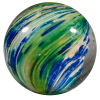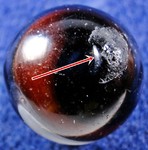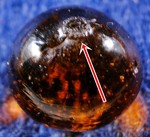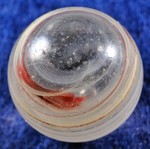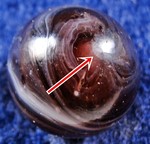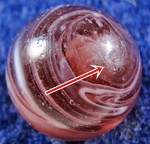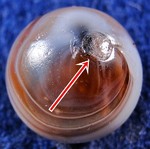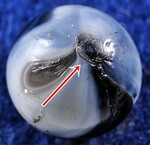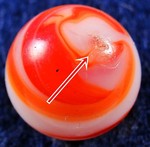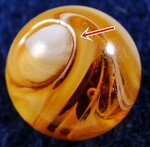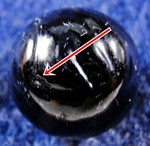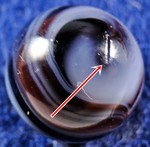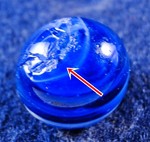TRANSITIONS
Transitional is the term used to collectively describe a variety of slag-type marbles that have pontils or shear marks on them. Amongst this type are the earliest German marbles, the earliest American-made marbles, as well as marbles from Japan and China.
The term “transitional” applies to most slag-type marbles that have one pontil. These marbles were made by one of several processes. Some were made by gathering molten glass from a pot onto the end
of a punty. This gob could then be rounded to a single marble and sheared off the punty, or a stream from a large gather of glass could be dripped off the end of the punty into a machine as another
worker cut the stream to create individual gobs of glass. Some later Transitionals were made completely by machine. In this case, the stream of glass came out of a furnace, through a shearing
mechanism, and then went into a crude set of rollers that rounded the marbles. If the rollers did not rotate them around all axes, or if the glass were too cool when it exited the furnace, the
cut-off mark from the shearing mechanism remained when the marble reached the end of the rollers.
These marbles are now collectively called “transitional” because they were initially believed to represent the transition from handmade marble making to machine marble making. We now know that
various transitional-type marbles have been made from the 1850s through the 1950s. The name now applies to most slag- type marbles that have pontil or shear marks.
The first marbles produced in Germany were single pontil slag type that are now referred to as Transitionals. A gob was gathered from a tank that contained a mixture of glass, and then sheared off
the punty using Greiner’s marble scissors. This began in about 1850. Many have Regular or Ground Pontils and are black, or dark green, with white. It is generally accepted that “Leighton”
Transitionals were produced in Germany. Virtually all “Leighton” Transitionals have come through England, which was the main destination of export from Germany.
Melted Pontil Transitionals were made using a process patented by J.H. Leighton in the late 1800s in Ohio. Several Ohio companies produced transitional marbles. Most of the companies
were short-lived. Among these were S.C. Dyke and Company, American Marble and Toy Manufacturing Company, National Marble and Specialty Company, Barberton Glass Novelty and Specialty Company, and
Navarre Glass Marble and Specialty Company.
Crease Pontil Transitionals are now accepted to have been produced in Japan or the Far East.
Pinch pontil Transitionals are believed to have been produced mostly by Christensen Agate Company early in its history.There has been some evidence gathered lately that some types of
Pinch Pontil Transitionals were produced in Canada.
Finally, some Regular Pontil Transitionals appear to have also been produced in China (the so-called “Shangai marbles”).
Transitional marbles are usually identified by the type of pontil, rather than country of origin. Some are also identified by the manufacturer, but this can be difficult at best.
All Transitionals are slag-type marbles. Ground Pontil Transitionals that are clear, blue or green base with a color swirled in a “9” pattern (sometimes oxblood) are commonly called “Leighton” marbles. These are rare.
There are six basic types of pontil: Regular, Ground, Melted, Pinpoint, Fold, Pinch, and Crease. The first three are handmade marbles, the last three are machine-made marbles.
Regular Pontil Transitionals have a pontil on one end that looks just like the pontil on a handmade marble. This type is fairly rare. These were individually hand-gathered on a punty and then rounded in a device and sheared off.
Ground Pontil Transitionals have a pontil on one end that has been ground and faceted. Many of these are Regular Pontil Transitionals that the manufacturer took the time to grind the pontil off of. They command about the same prices as Regular Pontil Transitionals, but they are not quite as rare. Some varieties of Ground Pontil Transitionals have oxblood and/or bright yellow or white swirled in. These are referred to as “Leighton” marbles, because it was popularly believed that an early marble-maker named James Leighton developed the colors used in these. This is now known not to be true, but the name has stuck. The “Leighton” Transitionals are very rare. Recently, some reproduction Transitionals with oxblood have appeared. Please see the reproduction section of the guide for information on those marbles.
Melted Pontil Transitionals are more common than either Regular Pontil or Ground Pontil. These are marbles that have a pontil on one end that has been partially melted into the marble. The pontil was either melted manually over a flame or else was melted into the marble surface while the marble was being formed by the marble making tool. Most Melted Pontil Transitionals exhibit either a “9 and swirl pattern” or else a looping pattern where the white runs in a band or bands from the pole, over the top of the marble, and back to the pole. The “9” pattern marbles (marbles where the white glass on the top pole forms a “9”) seem to be a little more common than the loop pattern marbles.
Pinpoint Pontil marbles are very rare. Occasionally, Melted Pontil Transitionals or Crease Pontil Transitionals are confused with Pinpoint Pontil Transitionals. The pontil on these marbles is characterized by a very tiny pontil that looks almost like the head of a pin. The pontil on these marbles was formed because the glass was a little too cool when it was sheared off and then dripped into the machine rollers. As a result, the cut-off spot did not completely melt into the marble because the marble cooled too quickly as it was forming. Occasionally, these very rare pontils are found on marbles that are made from two opaque colors of glass, rather than a transparent and opaque color.
Fold Pontil Transitionals are also rarer than Melted Pontils. The pontil is characterized by a tiny finger of glass that is folded over at the cut-off point and partially melted into the marble surface. This pontil is formed by a similar process to the Pinpoint Pontil. The glass was a little too cool when it sheared off into the machine. As a result, the cut-off spot did not completely melt into the marble because the marble cooled too quickly as it was forming.
Pinch Pontil Transitionals exhibit a short straight raised line on the bottom pole. Usually, the top pole has a “9” type configuration. The cut-off line on a Pinch Pontil is much straighter and usually much shorter than that seen on the Crease Pontils discussed below. The crease on Crease Pontils usually are about 1/5th to 1/4 the circumference of the marble. The pontil on a Pinch Pontil are usually less than 1/10th the circumference of the marble. There is still discussion amongst collectors over the age and origin of these marbles. It was generally believed that Pinch Pontil Transitionals are American made, probably early Christensen Agate Company. However, recent research has indicated that the marbles were made in Canada. The pontil is the remnant of a mechanized shearing process, rather than a hand-cut process.
Crease Pontil Transitionals are fairly common. It is believed that these were made in Japan, as they have been found in boxes exported from that country. These marbles are characterized by a spidery crease line that runs along the entire bottom of the marble. Again, the mark was formed because the glass was too cool when it was sheared off as it was dripping into the marble-making machinery. There is some speculation that this is a result of the lack of adequately efficient fuel sources in Japan. These marbles tend to be transparent blue, aqua, green or brown, with bright opaque white swirls in and on them.


